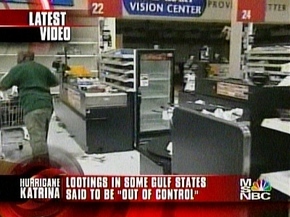 Source: Screen capture from CNN “Refusing to Leave” report by Dan Simon on the morning of 9-9-05.
Source: Screen capture from CNN “Refusing to Leave” report by Dan Simon on the morning of 9-9-05.
“This is America. Has your neighborhood ever been invaded by state troopers from another state?” “I will leave when I am dead.” Ashton O’Dwyer can’t understand why he is being forced to leave his dry, intact home in New Orleans. He asks the city: “Treat me with benign neglect.” The 9-9-05 report was followed up by Drew Griffin on 9-10-05 with the “Staying Put” report that presented businesses, and Afro-Americans, expressing sentiments similar to O’Dwyer’s.
Dr. Michael Baden on the “On the Record” Fox News show, hosted by Greta Van Susteren at about 9:47 PM central time on 9-9-05, stated that there was little danger from the “toxic” water unless people drink it. (Toxic water is the main reason given for the current, post-hurricane, forced evacuations.) Baden claims if the city wants to help people, they would be much more effective if they sprayed the water against mosquitoes.
(Dr. Michael Baden is the Chief Forensic Pathologist of the New York State Police, and was formerly the Chief Medical Examiner of New York City.)
Watch the CNN report: “Refusing to Leave“:
Watch the CNN report: “Staying Put“:
For more on O’Dwyer, see also:
CHRISTOPHER COOPER. “Old-Line Families Escape Worst of Flood and Plot the Future.” THE WALL STREET JOURNAL (September 8, 2005): A1.

